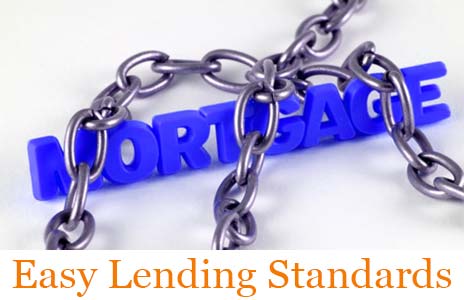
Good news for the prospective homebuyers in the country. Lenders are finally ready to ease the strict lending standards enacted post economic downturn and subprime mortgage disaster. The strict lending standards were implemented to boost the confidence of the shattered mortgage industry. While tight lending standards are still there in the country, lenders have started issuing loans to borrowers with poor credit score and low downpayments.
What compelled lenders to ease lending standards?
You must be wondering what has changed suddenly? What has brought this change in the mindset of lenders? Well, it is not that lenders have started feeling bad for the borrowers. It is just that they're concerned about their own profit margins. The sharp fall in the demand for refinancing and lower originations have made lenders uneasy. Several banks are fiercely competing with each other to generate profits, so much so that they are ready to issue loans to borrowers with low credit score.
There are some other factors as well that may help borrowers to obtain mortgage loans easily. Some of those factors are:
- The home prices are not fluctuating or plummeting nowadays. This boosts the confidence of lenders and mortgage insurers. They can at least recover primary losses incurred on low-downpayment.
- Fees on certain FHA administered loans have been gradually increased. These loans gave strength to housing market after recession since they were one of the few sources of low downpayment home loans. Borrowers are only required to make 3.5% downpayment on the loans.
Private insurance companies have become quite competitive for the borrowers with stellar credit after the FHA has increased insurance premiums on certain loans. This doesn't imply that it'll be quite easy to obtain mortgage. It just means that borrowers will get a wide range of options. That's it.
What is the current scenario in the mortgage industry?
In 2012, mortgage originations were $2 trillion and in 2013, the figure was $1.8 trillion. As per the Mortgage Bankers Association, the figure will drop to $1.1 trillion in 2014. This 36% drop in originations is mainly due to the drop in refinancing.
On 18th April, 2014, U.S. unit of Toronto-Dominion Bank started issuing loans with low downpayments (almost 3%) to moderate-income and first-time home buyers. They have started issuing loans through a program known as the Right Step. The program was there in 2013 also, but the downpayment requirement was 5% then.
Similarly, Valley National Bank, which happens to be a New Jersey-based community bank dropped the downpayment criteria from 25% to 5% on mortgage loans foe specific home buyers in the states like New York, Pennsylvania and New Jersey.
The next bank that is all set to lower downpayments on the conforming loans is the Arlington Community Federal Credit Union. They are going to accept 3% downpayment on loans from May 2014. Previously, borrowers had to pay 5% downpayment for the same loan.
As far as the non-conforming loans are concerned, borrowers have to make 10%-15% downpayment. This figure is yet again down from 20%.
It is not that low downpayment mortgage was not at all available. It is just that low downpayment mortgages moved to FHA loans from the private lenders post the subprime mortgage crisis. In the last one year, at least 1 in 6 loans issued outside of the FHA had a downpayment requirement of below 10%. This is the highest figure charged since 2008. Still, the figure is less than 44% of the market.
Usually Fannie and Freddie Mac buy mortgages with downpayments of around 5% or less than that if there is a mortgage insurance. The FHA has deliberately begun to raise fees for borrowers due to 2 main reasons. The first reason is to transfer a big share of the mortgage market to private lenders and attract borrowers towards private mortgage insurance.
Apart from the small lenders, Wells Fargo, the biggest mortgage originator in the nation has also eased credit requirements. They are allowing borrowers to make 5% downpayments with up to 2% of it coming as a gift. However, the borrowers need to have very good credit and be ready to pay for the mortgage insurance.
Another sign of easy lending standard is that credit score requirement for borrowers is also falling. As far as conventional loans are concerned, borrowers now need a minimum credit score of 755. In the last year (2013), the minimum credit score requirement was 761. Credit scores on FHA loans dropped to 684 from 696 as well.
Small mortgage lenders are issuing loans to borrowers with even less credit score. The average credit score has fallen from 715 to 679.
Are lenders making a serious mistake by easing lending standards?
Well, this fear will always be there. Whenever people talk about easy lending standard, their minds immediately recall the housing market crash. They start wondering if lenders are repeating mistakes of the bubble days yet again.
It is too early to think that lenders are making the same mistake. Till now, there's no such suggestion that products or services (which were mainly responsible for the housing market crash) are making a re-appearance. It is true that low down payments carry greater risks than that of the large downpayments. However, if you think clearly, you'll remember that low downpayments were not responsible for the housing market crash. Moreover, lenders are not ready to issue loans to borrowers with trashed credit. Besides, borrowers still have to verify incomes to qualify for loans.
Conclusion:
Even though lenders have begun easing lending standards, economists are very much worried. At the present time, lending standards are extremely strict and not that liberal.
What is your experience? Do you feel that it has become slightly easier to be eligible for loans? Share your thoughts and opinions.

